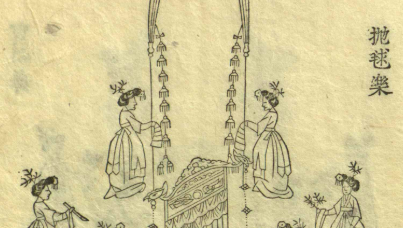Lesson Plan
Guide to Creating Your Own Linguistic Diversity Project!
Language Information
Below is information for some of the languages used within the Bi-Co.
Mandarin (普通话)

Mandarin, or 普通话 (Pǔtōnghuà), is the most widely spoken language in the world with 1,116,596,640 speakers, according to Ethnologue. Mandarin is a Sino-Tibetan language (Ethnologue). The language is spoken in many different regions of China, including Guangxi Zhuang Autonomous Region: northwest; Guizhou province; Hubei province: except southeast corner; Hunan province: northwest; Sichuan and Yunnan provinces. Widespread north of Changjiang river, from Jiujiang to Zhenjiang, according to Ethnologue. Mandarin uses the Han script (Ethnologue).
Mandarin is a tonal language, meaning that words have different meanings depending on how they are pronounced. Mandarin has four (or five) tones: high, rising, falling and rising, and falling. There is also a neutral tone (Chinese Pod). Here is a video that further explains the tones of Mandarin.
Example sentences (from a native speaker): 你好。/ Nǐ hǎo. “Hello.”
我会说普通话。/ Wǒ huì shuō pǔtōnghuà. “I can speak Mandarin.”
Spanish (Español)

Spanish, or Español, is spoken by 534,335,730 people worldwide, according to Ethnologue. Spanish is a widespread language, spoken in countries such as Spain, Mexico, and most countries in South America, according to Ethnologue. Spanish is a Romance language and is a member of the Indo-European language family, according to Ethnologue. There are many different dialects of Spanish, including Andalusian, Aragonese, Murcian, Navarrese, Castilian, Canary Islands Spanish (Isleño), American Spanish (Chicano), and Silbo Gomero (Ethnologue). Spanish uses the Latin script (Ethnologue).
Example sentences (SpanishDict): Hola. ¿Cómo estás? “Hi. How are you?”
Hablo un poco de español. “I can speak a little Spanish.”
Japanese (日本語)

Japanese, or 日本語 (Nihongo), is spoken by a total of 128,350,830 people (Ethnologue). Japanese is a widespread language, spoken in most areas of Japan, as well as countries such as Australia and the United States (Ethnologue). Japanese is a Japonic language. The Japonic language family is considered a language isolate because it is unrelated to any other language families (Britannica). However, according to Ethnologue, the Japanese language may be related to Korean, which is also considered a language isolate. Japanese uses the Han, Hiragana, and Katakana scripts (Ethnologue).
Example sentences (native speaker): こんにちは. / Konnichiwa. “Hello.”
日本語は少しだけ喋れます. / Nihongo ga sukoshi dake shaberemasu. “I can speak a little Japanese.”
Korean (한국어)

Korean, or 한국어 (Hanguk-eo), is spoken by 77,264,890 people worldwide (Ethnologue). The language is widespread in South Korea but is also spoken in Japan and China (Ethnologue). The Korean writing system is called 한글, or Hangul (Ethnologue). It is debated as to whether Korean is a language isolate or whether it is related to Japanese (Ethnologue). There are many different dialects of Korean, including Seoul (Kangwondo, Kyonggido), Chungcheongdo (North Chungcheongdo, South Chungcheongdo), Kyongsangdo (North Kyongsangdo, South Kyongsangdo), Jeollado (North Jeollado, South Jeollado), Jeju Island (Ethnologue).
Ex. sentences (Talk to me in Korean): 안녕하세요. / Annyeong haseyo. “Hi.”
한국어 조금 할 수 있어요. / Naneun hangugeoreul jogeum hal su isseoyo. “I can speak a little Korean.”
Cantonese (粵語)
Cantonese, or 粵語 (Yuht Yúh), is spoken by 73,538,610 people worldwide (Ethnologue). It is spoken in the following regions: Guangdong province: most except Hakka-speaking areas northeast, and Min Nan-speaking areas east; Guangxi Zhuang Autonomous Region: east; Hainan and Hunan provinces (Ethnologue). Cantonese is a Sino-Tibetan language (Ethnologue). There are a few dialects of Cantonese, including Siyi, Gaolei (Gaoyang), Qinlian, Guinan, Ping, Bobai, Tengxian, Cangwu, Yangjiang, Zhongshan, and Guangzhou (Ethnologue). Cantonese uses the Han script (Ethnologue). Cantonese is a tonal language, with a total of six tones: high pitch level, low-mid to high rising, mid-pitch level, low-mid to low falling, low to low-mid rising, low-mid level (Cantonese).
Example sentences (Cantonese): 你好嗎? / Lei5 hou2 ma3? “How are you?”
你食咗飯未呀?/ Lei5 sIk6 dzo2 fan6 mei6 a3? “Have you eaten yet?”
Polish (Polskie)
Polish, or Polskie, is spoken by 40,378,030 people worldwide (Ethnologue). Polish is widely spoken in Poland, but it is also spoken in Germany, Hungary, Lithuania, and other countries (Ethnologue). It is a Slavic language and is a member of the Indo-European language family (Ethnologue). Polish uses the Latin script (Ethnologue). According to Ethnologue, there are two main dialects of Polish: Upper Silesian and Masurian.
Example sentences (from a native speaker): Cześć. “Hello.”
Ja mogę mówić trochę po polsku. “I can speak a little bit of Polish.”
Further Resources
- A.W. Strouse, on linguistic diversity in the classroom
- Cummins 1997, on linguistic diversity in education
- LSA page on linguistic diversity
- Spolsky and Shohamy, on Language Ideology and policy
- Woolard and Schieffelin, on linguistic diversity